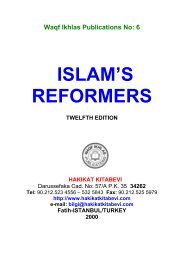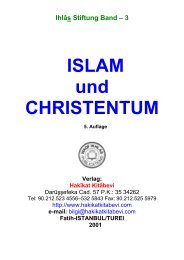1 - Endless Bliss - Hüseyin Hilmi Işık
1 - Endless Bliss - Hüseyin Hilmi Işık
1 - Endless Bliss - Hüseyin Hilmi Işık
Create successful ePaper yourself
Turn your PDF publications into a flip-book with our unique Google optimized e-Paper software.
ook of Tafsîr entitled Baydâwî that after staying here until the<br />
twenty-third of September, when day and night are of equal<br />
length, they spent the day here and left for Medîna on the<br />
twelfth of Rabî’ul-awwal, a Friday, arriving in the blessed city on<br />
the same day. Later, during the caliphate of ’Umar ul-Fârûq, the<br />
first day of the month of Muharram of that year, which was<br />
sixty-six days before the Hijrat, became the beginning of the<br />
Muslims’ Hijrî kamarî calendar. That first day, according to<br />
historians, was in the year 622 A.D. It is written in Ahmad Ziyâ<br />
bey’s book Ilm-i Hey’et, printed in 1316 [1898 A.D.], that it<br />
corresponds with Friday, the sixteenth of July. The beginning of<br />
Muslim’s Hijrî shamsî year (Hegira solar calendar) is the day<br />
when he entered the village, Kubâ, which was the 20th of<br />
September. The first day of the year of 623 A.D. was in the first<br />
year of the Hegira solar calendar, and lunar calendar.<br />
One solar year contains 365.342 days. And one lunar year<br />
contains 354.367 days, that is, 354 days plus eight hours plus<br />
48.5 minutes.<br />
He went to war twenty-seven times, nine times of which he<br />
attacked as a soldier, and the other times he occupied the rank<br />
of commander-in-chief. He used two types of flags in his holy<br />
wars. His Râya was black. His Liwâ, which was smaller, was<br />
white. We have already explained in the twenty-ninth chapter of<br />
the first part (of the Turkish version) that the banner of the<br />
Ottoman State was designed by Timurtaş Paşa.<br />
In the city of Medina, he passed away before noon on<br />
Monday, Rabî’ul-awwal 12th, 11 [632 A.D.], when he was 62 or<br />
61, according to the calculations done by using the lunar<br />
calendar or the solar calendar, respectively. Without taking his<br />
holy shirt off, he was washed three times, was wrapped with a<br />
new white shrould folded three times, and was buried where his<br />
blessed soul was taken.<br />
Sarwar-î âlam’s (Muhammad) blessed eyes used to sleep,<br />
but his blessed heart would not sleep. He used to go to bed<br />
hungry, but he would feel satiated when he got up. He never<br />
yawned. His blessed body was luminous, and he never cast a<br />
shadow on the ground. Flies didn’t alight on his clothes, nor<br />
would mosquitos or other insects suck his blessed blood. When<br />
he was made Rasûlullah (Allah’s Messenger) by Allahu ta’âlâ,<br />
satans could not ascend to the sky and could not get news any<br />
longer, nor could soothsayers make predictions.<br />
- 231 -




